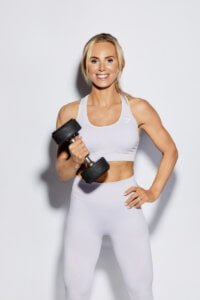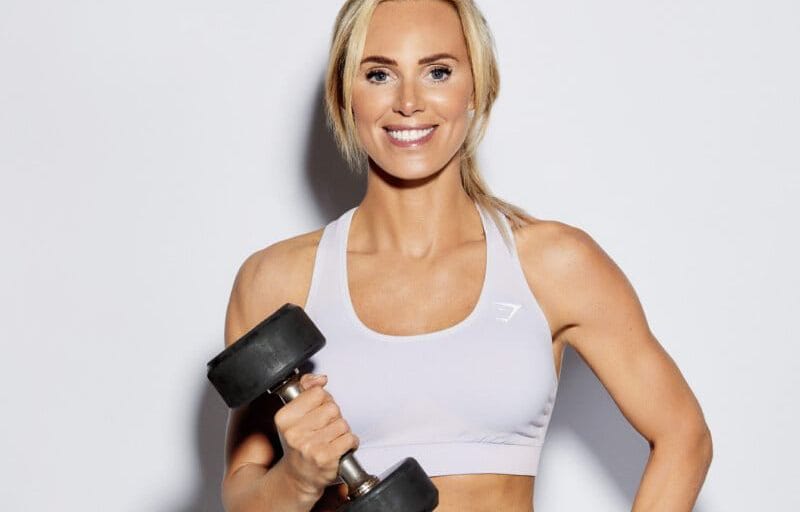 Sarah Lindsay, a triple Olympian former speed skater and personal trainer to the stars, reveals the rewards of transitioning from cardio to strength training and how to excel in your weight training workouts.
Sarah Lindsay, a triple Olympian former speed skater and personal trainer to the stars, reveals the rewards of transitioning from cardio to strength training and how to excel in your weight training workouts.
Sarah Lindsay, co-founder of Roar Fitness, says: “There are huge psychological benefits to cardio exercise, often because the exercise is done outside. You might get an initial buzz but a lot of cardio will make you feel tired. But over time, although you might get better at running, you’ll lose weight, which means you’ll also lose muscle.
Strength training or weight training, on the other hand, is more time efficient and builds the body up.
As we age, sustaining and creating muscle through weight training is crucial. By lifting weights, we create an inner armor that balances our body and protects against age-related issues like osteoporosis and arthritis.
Muscle also enables your body to burn calories faster. During a weights workout, you create microscopic tears in the muscle fibres, which take several days to recover from and during this time because muscle is an active tissue, you’ll continue burning calories even during periods of rest. Even a couple of pounds of extra muscle boosts the metabolism, which allows your body to burn calories faster.
And unlike cardio conditioning, which drops off after a couple of weeks, strength gains from weight training last a long time so after a short period of inactivity, your muscles will remember how to grow. We all know that life sometimes gets in the way of our fitness goals, but the good news is all is not lost if you have two weeks off weight training.
There are no downsides to being strong. When you’re physically strong and capable, you’re mentally strong and capable.”
Sarah Lindsay’s top 6 tips to win during a weights workout
Master the Basics of Strength Training
If hiring a PT isn’t an option, learn some basic weight lifting moves by hitting the internet and finding a beginners programme. Watching videos of experts doing the exercises is the way to get to grips with form and technique. In front of a mirror at home, start without weights, copy the movements, listen to the points of technique and ask yourself, ‘Do I look like the person in the video?’. Once you can answer, ‘Yes’ that confidence to the gym and start using weights. Then don’t expect your first session to feel good. You probably won’t feel comfortable with lifting weights until you start making progress after a few sessions. Give yourself time. Once you start lifting more, I promise you’ll love it.
Structuring Your Weight Training Workouts
You can’t walk into a gym and pick up a dumbbell with zero idea of what you’re doing. If you prefer the idea of a gym workout over an online class at home, write down a plan of the exercises you’re going to do during that session. Every athlete takes a workout programme into the gym. Don’t feel like you’re a novice because you’re carrying a bit of paper. That’s what everyone should take the time to do, otherwise you’re just winging it. Everyone feels uncomfortable walking into a new gym – even me! Just swallow, take a deep breath, walk in and execute the plan that you have created. Another option is to download Roar At Home and follow one of the weights circuits in the gym on your Smartphone!
I also recommend working out in the morning because there’s less time for life – emails, phone calls, kids’ demands – to get in the way and you have less time to talk yourself out of the exercise. A 30 minute workout three times a week is adequate for most people to achieve results.
Embrace Progressive Overload in Resistance Training
“I don’t want to bulk up” – I hear this almost every time I’m creating a programme for a new female client. Bulk is a horrible word to describe a thought or a look but it’s a very rare result of weight lifting. If you start weight training and sort your food out, the body fat will come down and you’ll start to build a physique. Unlike with cardio, you don’t need to spend hours and hours weight training and you’ll begin to see changes to your body in about three weeks.
To continue getting stronger, the muscle needs progressive overload, which means it needs to be challenged. As soon as the movement becomes too easy, you’re no longer making progress so need to add more weight.
Lift as much weight as you can for the given reps. As long as you’re doing the movement properly, the weight should be challenging enough to make it hard. By ten reps, you should feel it is hard to complete any more. Between 5kg and 10kgs is a good weight to start. But work with what you’ve got. If you’re doing a lunge, only have 10kg dumbbells and feel it’s too hard to carry weights in both hands, modify the exercise slightly by holding one 10kg weight with both hands, close to your chest.
Pushing Through Challenges in Your Strength Training Journey
No-one loves the burning feeling when a muscle is being challenged, so learn to love the results that the pain brings. Feeling a sense of achievement after that extra bicep curl or five additional goblet squats, knowing you’re progressing and feeling stronger counteracts the discomfort. That’s highly motivating both physically and emotionally. If you’ve broken your personal best or completed a workout that you didn’t feel up for that morning, you feel badass and that confidence carries through into other areas of your life.
Nutrition for Effective Weight Training
Eat after you train to aid your recovery by rebuilding your body’s glycogen stores and muscle protein, which get used up during exercise. Generally, whatever you eat for 20 minutes after a workout will unlikely be stored as fat. Instead, the food you eat will go to the muscles and be stored as energy for the next session so plump for a carb and protein-packed foods such as eggs and avocado on wholemeal toast, chicken with salad and rice or Greek yoghurt, berries and granola. If after a hard session you find it hard to digest food, a protein shake may be a relevant option.
Optimising Your Strength Training Schedule
If the day after a weights workout you feel fatigued and don’t feel able to workout, take a rest day but if you’ve still got energy and want to exercise, do so! I believe in doing some form of exercise every day. Aim for three weight training workouts a week and throw in other forms of exercise – a half hour walk to and from the shops, some lovely stretching exercises, even doing laps of your garden while on a work call, which I did the other day!
Sarah Lindsay’s top 5 weight training moves for beginners
“The body does a range of movements – it pushes, it pulls, it flexes at the hip, it squats and it presses overhead,” says Sarah. “Get strong at these basic moves, then once you start to build a physique, you can grow your repertoire of movements.”
Dumbbell Deadlift: Foundation of Strength Training
- Grab dumbbells – or a bar if possible – and lower the hips back and down
- Lift chest, retract shoulders and sit the hips back and down while holding dumbbells
- Brace core and drive evenly through feet to stand up
- Reverse the movement and lower dumbbells with control
ROAR TIP: Start off lifting lighter than you feel you can lift then add weight as you grow in confidence.
Chest Press: Building Upper Body Strength with a Workout Bench
- Lie on bench or chair with knees bent holding a pair of dumbbells at shoulder height
- Set shoulder blades back and down
- Press dumbbells up to ceiling
- Lower weights slowly to starting point
ROAR TIP: Target pectoral muscles by bending elbows slightly and not locking out at the top.
Seated Dumbbell Press: Develop Shoulder Power
- Sitting on a chair, hold a pair of dumbbells at shoulder height with palms facing forward
- Brace core and press weights overhead
- Lower dumbbells to start position
ROAR TIP: Push your feet into the floor to create a solid base to push from.
Split Squat: Enhance Lower Body Stability
- Start with one foot in front of the other.
- Slowly lunge forward, loading the weight onto the front foot.
- Drop the back knee to the floor.
ROAR TIP: Keep the body upright then push straight back up.
Body Extension: Engage Your Core and Improve Flexibility
- Lie on your back, extend your arms and legs out straight (add a dumbbell if you’re feeling strong). Keep your head on the floor and your torso still.
- Raise your arms and legs straight up in the air then slowly lower your arms over your head and your legs down to the floor keeping them both straight.
- Your lower back will develop a natural curve. Don’t push it into the floor but don’t let the angle of the back change.
Ready to start your strength training journey? Book your free consultation with our expert trainers today and unlock your full potential!

